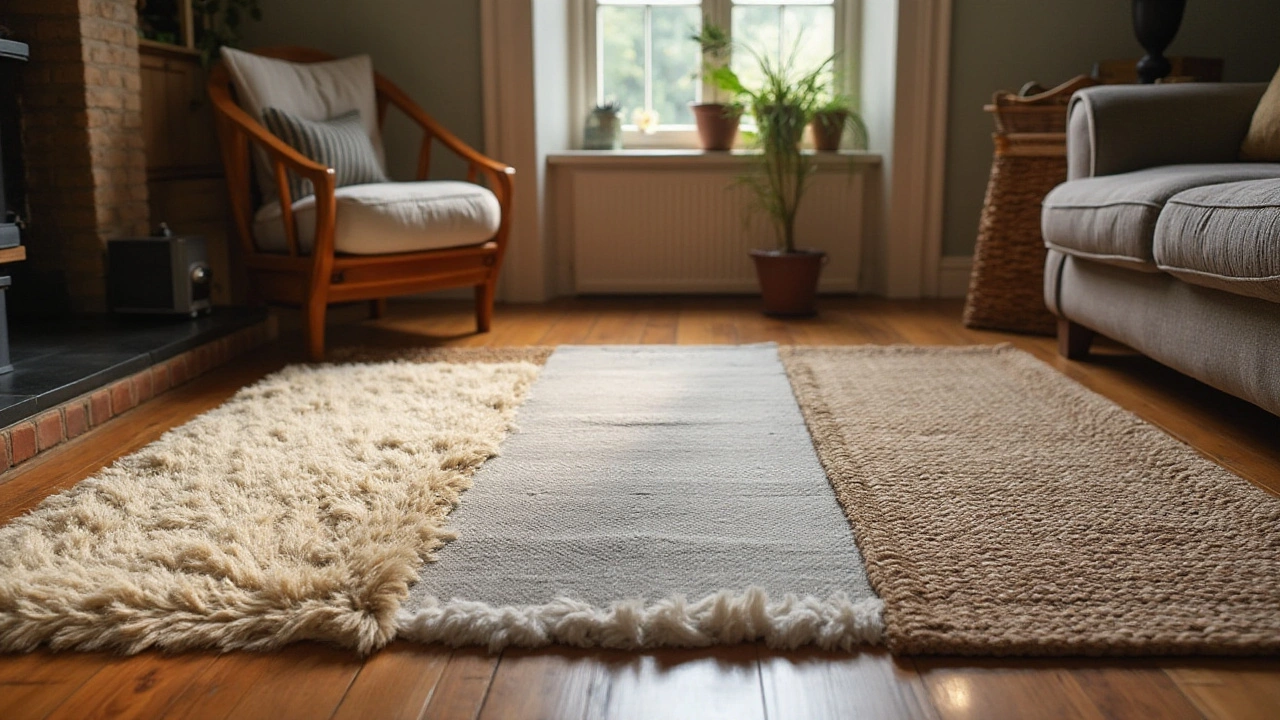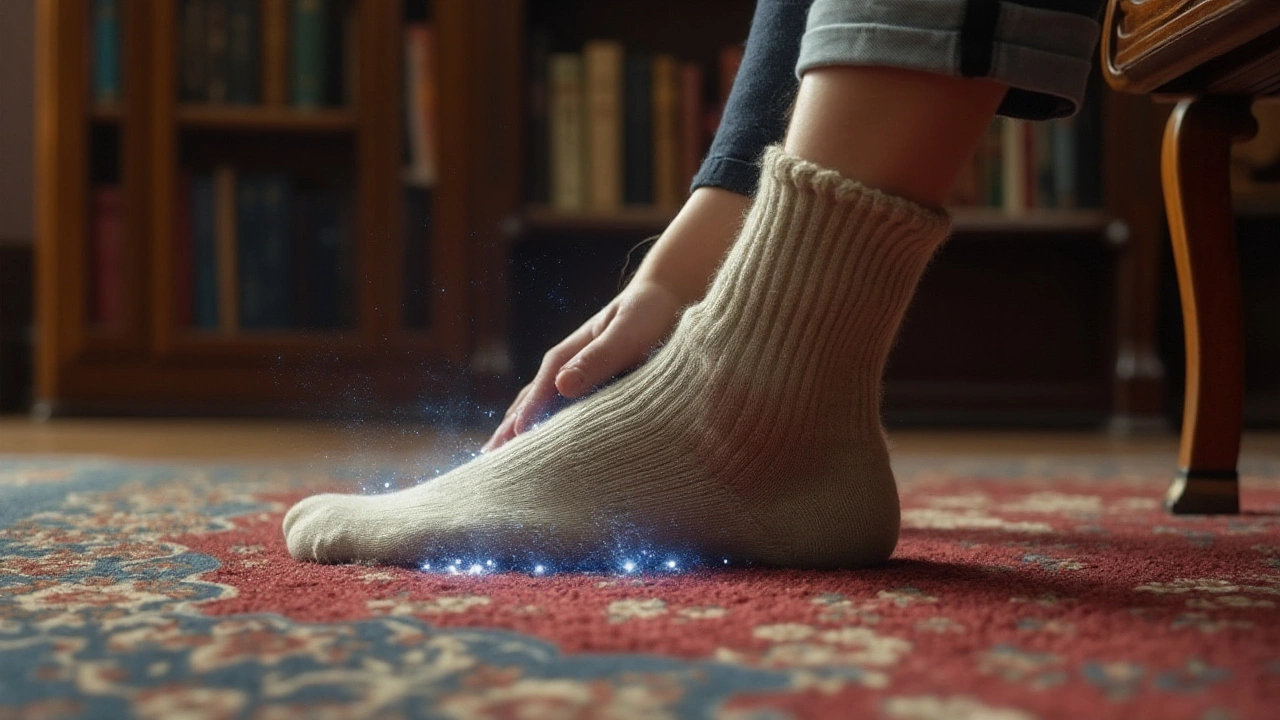Ever wondered why you get that pesky shock after shuffling across the room on a plush carpet? It’s more intriguing than it seems. When you rub your feet on a rug, you're part of a miniature science experiment happening right under your toes. While it might just seem like an annoying zap, what's really happening is the build-up of static electricity—a fascinating and quite common household phenomenon.
This dance of electrons can vary from rug to rug, with some materials sparking more magic than others. While understanding the science can help in mitigating unwanted shocks, embracing it might even offer unexpected practical uses. Let's dive into the curious world of static electricity and what your floor coverings have to do with it. Whether you're looking to light up a party trick or simply wanting to keep your shocks to a minimum, there's much to explore and learn.
- The Science Behind Static Electricity
- Rug Materials and Static Charge
- Benefits of Understanding Static
- Practical Tips to Reduce Static Shock
- Creative Uses for Static Electricity
The Science Behind Static Electricity
Static electricity is a charge that builds up on the surface of an object. It's the reason why you might feel a shock after touching a doorknob or shaking hands with someone after walking across a rug. This happens because of a fascinating exchange at the atomic level. Essentially, when you rub your feet on a rug, what you're doing is causing a transfer of electrons between your body and the rugs. The friction generated creates an imbalance, leaving your body with either a positive or negative charge. This imbalance wants to right itself, which is why you feel that familiar jolt when making contact with a conductor, like a metal doorknob, which facilitates the flow of these static charges back to equilibrium.
The phenomenon of static electricity was first formally recognized in the 17th century by English scientist William Gilbert, though humans have observed its effects since ancient Greece. To understand it on a deeper level, it's crucial to think about atoms, which are the building blocks of everything around us. These atoms consist of a nucleus with protons and neutrons, surrounded by electrons in orbit. Pretty naturally, electrons are itching for a reason to jump to a different atom, especially when different surfaces come into contact. The key here is that some materials, like rubber soles and certain fabric fibers, are particularly good at creating static because they hold onto electrons tightly, which leads the charge to stay put for longer periods.
Why Rugs Create Sparks
Different fibers in rug materials contribute variably to static electricity. Synthetic fibers such as polyester and nylon are particularly notorious for clinging on to electrons, hence ramping up the static charges. This meticulous dance of electrons is noticeable during colder months when the air is much drier—a particular condition that limits the movement of electrons towards water molecules in the air. By contrast, woolen rugs or those made of natural fibers tend to dissipate these charges more rapidly, due to their inherent moisture content. Consequently, the clip-clap across a Betsy Braided Beauty Rug might just be a more forgiving wintertime choice in terms of static shock.
"If we can harness electricity, not only in its grand forms, but also in subtlety, such as in static charges, we could revolutionize our understanding of everyday phenomena," remarks physics professor Dr. Elaine Hennessey.
Static electricity isn't confined to just discomfort though; it has practical applications, too. Photocopiers and laser printers, for instance, use static electricity to attract toner particles to paper, highlighting how these everyday shocks also power our modern conveniences. Thus, while walking across a rug and generating static electricity might seem trivial, recognizing its potential impacts fosters a greater appreciation for the forces at play right beneath our feet.
Rug Materials and Static Charge
The connection between rug materials and static electricity is as intricate as it is surprising. The propensity of a rug to generate static electricity is largely dictated by the materials it's woven from. Natural fibers like wool, cotton, and silk are generally less prone to building up a significant static charge because they contain moisture, which helps dissipate the charge. Wool, especially, is prized for its ability to resist static buildup while maintaining warmth and durability.
In contrast, synthetic fibers such as nylon, polyester, and acrylic are notorious for their tendency to cling to electrons. Nylon, for example, is a common culprit behind those post-rug walks that leave you wincing with every touch. This synthetic is not only durable and resistant to stains, but it also loves to hold onto an electric charge. When your feet rub against a nylon carpet, electrons are exchanged between them, leading to a noticeable static shock.
The construction of the rug also plays a role. Cut pile rugs, which feature fibers that stand upright, can generate more static compared to loop pile carpets. This is because the surface area available for friction increases, which is essential in static charge accumulation. Understanding these differences can guide you in choosing the perfect rug for your home, particularly if you're aiming to minimize those unexpected shocks.
According to a renowned textile engineer, "Avoiding synthetic materials can reduce static, yet what really helps is maintaining proper humidity levels within your home, as dry air contributes to the problem." This advice is echoed by many in the field who recommend the use of humidifiers during dry seasons.
For the curious homeowner, there's more than just personal comfort at stake. Static electricity can affect sensitive electronic equipment by attracting dust, which might compromise their efficiency over time. To visualize how conductive different fibers are, consider the table below:
| Fiber Type | Static Conductivity |
|---|---|
| Wool | Low |
| Polyester | High |
| Cotton | Medium |
| Nylon | Very High |
Arming yourself with this knowledge is not just about buying the right rug; it's about enhancing the way you interact with your living environment. You may even find yourself experimenting with different materials to find the perfect fit for both your lifestyle and style preferences. Remember, every home decor choice has a ripple effect, and understanding the link between rug fibers and static electricity is another step toward creating a more comfortable and shock-free sanctuary.

Benefits of Understanding Static
Static electricity might seem like a purely pesky phenomenon, especially when it leads to unexpected shocks, but there's a wealth of benefits in understanding it that stretch beyond avoiding discomfort. For starters, having a grasp of static electricity can significantly elevate your awareness of how electricity works in general. This knowledge doesn't just keep your own static encounters at bay; it broadens your understanding of electronics and energy flow in your home, influencing everything from gadget safety to energy efficiency. The ability to control and predict static behavior can surprisingly enhance your home environment, making it both safer and more enjoyable.
Moreover, static electricity plays a subtle yet impactful role in various industrial and scientific applications. Did you know that static charges are pivotal in the function of xerographic copiers and air purifiers? Understanding the role of static allows you to appreciate the intersection of electricity and technology that often goes unnoticed in everyday life. In certain industries, such as in graphic design, inkjet printing relies on static charges to ensure the precision of ink droplets, which translates to the vibrant prints we admire. Recognizing these functions can inspire new ways to think about the sustainable application of energy, even on a smaller scale at home.
Fascinatingly, the more you learn about static, the more you start to see its presence in unexpected places. For example, companies in the textile industry are continuously working on reducing static-cling in fabrics, leveraging scientific advances to enhance comfort in our everyday wear. Likewise, static electricity is crucial in preventing accidents in industries handling flammable substances, as grounding measures are often employed to neutralize charges that could lead to dangerous sparks. Static electricity, though invisible, is a powerful reminder of how seemingly small forces can have vast impacts. Understanding this can change how we build and live in our spaces, nudging us towards safer, smarter choices.
"Static electricity might appear trivial, but it is an invisible force that can have a profound impact on day-to-day life and industry alike," notes Dr. Katherine Lang, an expert in electrical processes, in her extensive research on electrostatic phenomena.
Exploring static electricity isn't just an academic exercise; it's also a gateway to enhancing creative problem-solving skills. For instance, in understanding static, homeowners can experiment with innovative techniques—like humidifiers to mitigate dry-air-induced charges or opting for rugs with natural fibers that resist static buildup. Comprehending the environment's interplay with static directly translates to making informed decisions about home decor, including selecting the right rugs. Whether the concern is about comfort, aesthetics, or minimizing those annoying little shocks, a well-informed choice becomes easier.
Taking the time to understand static electricity and how different materials respond to it provides a groundwork for educated choices around the household. It's a simple step that can prevent significant nuisances, aid in maintaining delicate electronics, and perhaps even inspire creatively charged endeavors. From reducing the possibility of electrical mishaps to helping you choose the best rug material for a cozy, non-shocking home, the benefits of understanding static are compelling and unexpectedly wide-ranging. The world is electric, and understanding static is just a part of uncovering its mysteries.
Practical Tips to Reduce Static Shock
Static electricity might just be the most uninvited guest in your home, responsible for those little shocks that catch you unawares. But there are some simple ways to make your living space a static-free zone. One method is to consider the type of rug materials you use. Natural fibers like wool tend to generate less static charge compared to synthetic materials like nylon or polyester. If you do love your synthetic rugs, fear not! Adding anti-static spray can significantly minimize unwanted zaps. These sprays work wonders by increasing the conductivity on the rug surface, helping static electricity dissipate quickly.
Adjusting the humidity level in your home is another effective strategy. Static electricity thrives in dry environments, particularly when the relative humidity dips below 30%. Using a humidifier to maintain levels above this magic number can be a game-changer. As the moisture in the air increases, it allows the electric charges to disperse more effectively, reducing static buildup. And remember, hydrating your skin can also help since dry skin is more prone to static electricity. A touch of lotion goes a long way in providing a barrier against electric charges.
Let’s not forget about your choice of footwear. Rubber-soled shoes can act as excellent insulators, preventing static charge from leaving your body and leading to a surprise shock. Opting for leather-soled shoes, in contrast, can help you stay grounded. Think of it as a more comfortable way of discharging that excess electricity!
Additionally, creating a grounded environment is crucial. This might sound a bit technical, but it's simpler than it seems. Try touching conductive materials periodically as you move around, such as metal doorframes or water pipes. This action will help transfer any electric charge away from your body safely. This concept is so prevalent that NASA uses grounding techniques extensively when designing space suits, to prevent static issues even in zero-gravity environments.
"The best way to combat static electricity is proper grounding," said a NASA space suit engineer in a 2022 seminar.
If you enjoy DIY solutions, here's a quirky tip: place a small bowl of baking soda on top of a rugs. Baking soda is known to neutralize static effectively and is incredibly easy to replace. For those more tech-savvy, numerous anti-static devices are available in the market these days. Anti-static wristbands, for example, are not just for computer nerds. Wearing one while lounging on the couch or working at your desk can keep static charges from building up.

Creative Uses for Static Electricity
Have you ever thought of static electricity as more than just a shocking nuisance? This seemingly bothersome reaction when you rub your feet on a rug can be harnessed for practical and entertaining uses. Static electricity, generated easily from everyday actions, finds applications both in scientific explorations and fun, hands-on activities at home. By understanding and creatively using this force, new doors of experimentation and education open up. So, let’s explore how this often-overlooked energy can be put to work in a fascinating way.
A simple and engaging project using static electricity is the foil electroscope. It’s an effortless way to teach children and adults alike about electron movement and electrical charges. Begin by cutting two strips of aluminum foil about the size of matchsticks and hanging them from a paperclip inside a glass jar with a lid. Rub a balloon on a wool rug to charge it, then bring it close to the lid without touching. Watch in amazement as the foil strips repel away from each other, demonstrating the invisible forces at play.
Another intriguing use of static electricity is found in air purifiers. These devices often use charged plates that attract and trap dust particles, effectively cleaning the air in your home. This method highlights how static electricity can work in reducing pollutants without the need for chemical filters. It’s a simple principle but contributes significantly to improving air quality and maintaining a healthier environment. Static’s ability to attract charged particles is used by scientists to study atmospheric phenomena. By measuring static charges in the atmosphere, researchers can predict and better understand the behavior of electrical storms and other related phenomena.According to National Geographic, "Static electricity is an omnipresent, invisible force in our environment that can be both cumbersome and curiously useful."
If you're into crafts, the use of static electricity to paint with powdered pigments offers a unique technique. By charging a surface like a canvas using static electricity from a rug or specialized cloths, you can apply dry pigments that will adhere effortlessly, creating vibrant and dynamic art pieces. This electrostatic painting method also minimizes waste and overspray, making it an eco-friendly alternative to traditional liquid paints.
In the tech-savvy world, static electricity serves as more than an exhibition gimmick. Ingenious inventors have devised devices that harness static electricity to develop low-power electronic circuits. Although these innovations are still in the early stages, the potential for powering small, low-energy devices using our feet on rugs is tantalizing. Imagine charging your remote-control battery just by walking around your living room!







